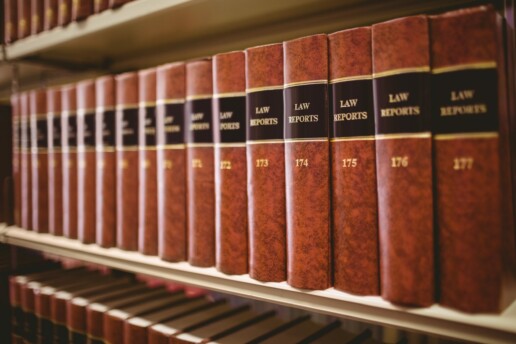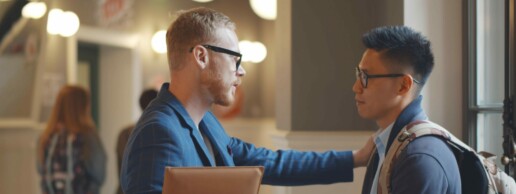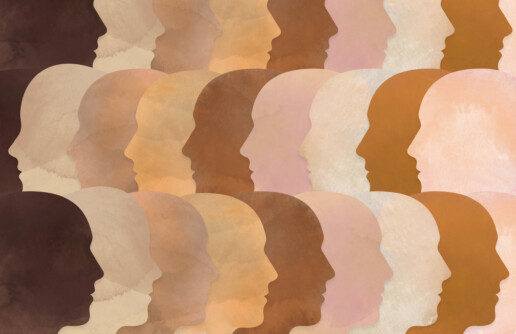Relationship Quality by Age
At a recent LSSSE webinar, one insightful participant wondered whether the trend younger law students that we outlined in our recent annual report might be related to a corresponding ongoing decline in relationships with administrative staff. In this blog post, we will explore the relationship between law school student age and quality of their relationships with law school faculty and staff.
Law students generally enjoy satisfying relationships with others at their law school. LSSSE respondents are asked to rate their relationships with other students, law school faculty, and law school administrative staff on a 7-point scale. We consider a rating of 5 or higher to be a positive relationship. Typically, law students are most highly satisfied with their relationships with each other, followed by their relationships with faculty, and finally they tend to be least satisfied with relationships with law school staff.
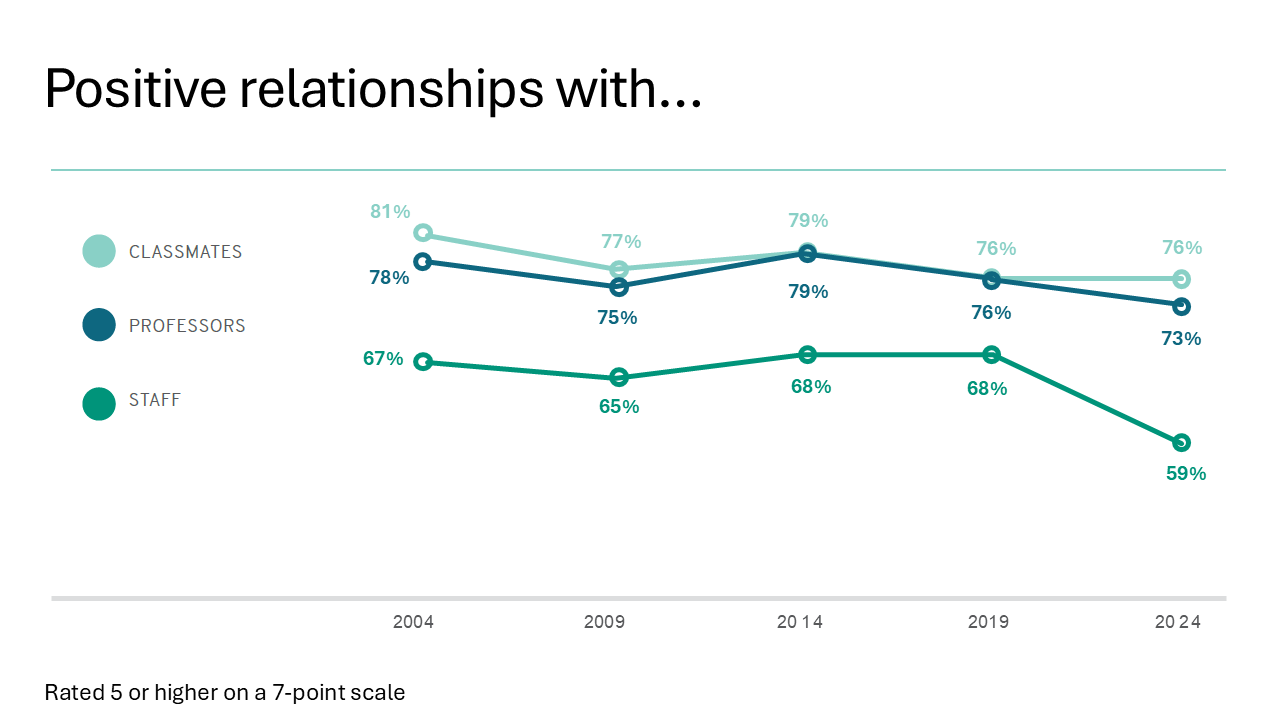
There is much less variability by age in the percentage of students with strong relationships with faculty compared to the percentage of students with strong relationships with staff. In other words, most students have strong relationships with faculty, but certain age groups of students are more likely to have strong relationships with staff than others. The hypothesis about student age and quality of relationships with staff seems to be mostly supported. The oldest students (those over age 40) are most likely to have strong relationships with administrative staff. Students in the 23-30 range are the least likely to have strong relationships with administrative staff, and students in their thirties fall in between. Most age groups have showed a decline in recent years, and it doesn’t appear that any age group has experienced a more precipitous decline than the others. The one notable exception is the youngest group of students—those under the age of 23. These students have been more likely to be satisfied with their relationships with staff in recent years, nearly reaching the same levels as the over 40 group in 2024.
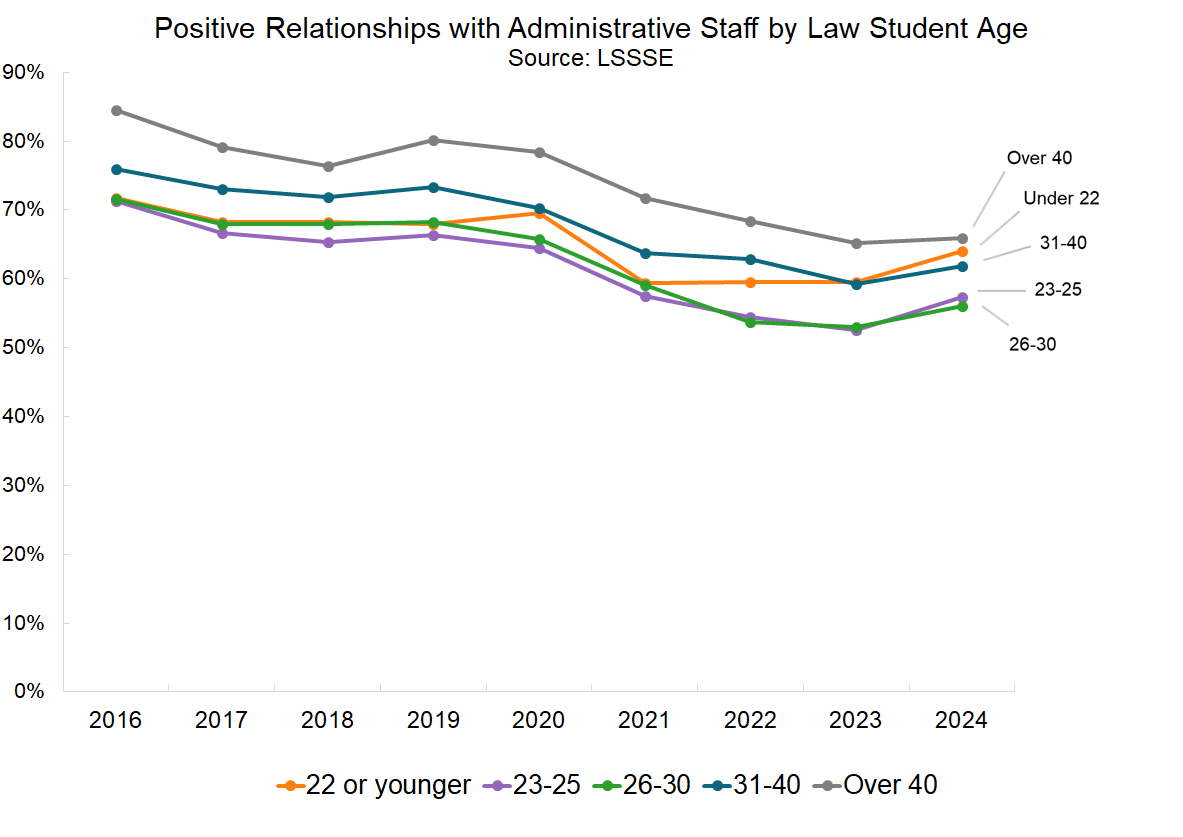
Overall, students are much more likely to have strong relationships with faculty than with administrative staff, which makes sense given that students are likely to work more closely with faculty and see them more often. However, parsing the relationship data by age shows the same general pattern: the oldest students are most likely to have strong relationships, the youngest students are the least likely, and the middle group falls somewhere in between. In this instance, the 22 and under group appears nearly indistinguishable from students in their thirties in recent years.
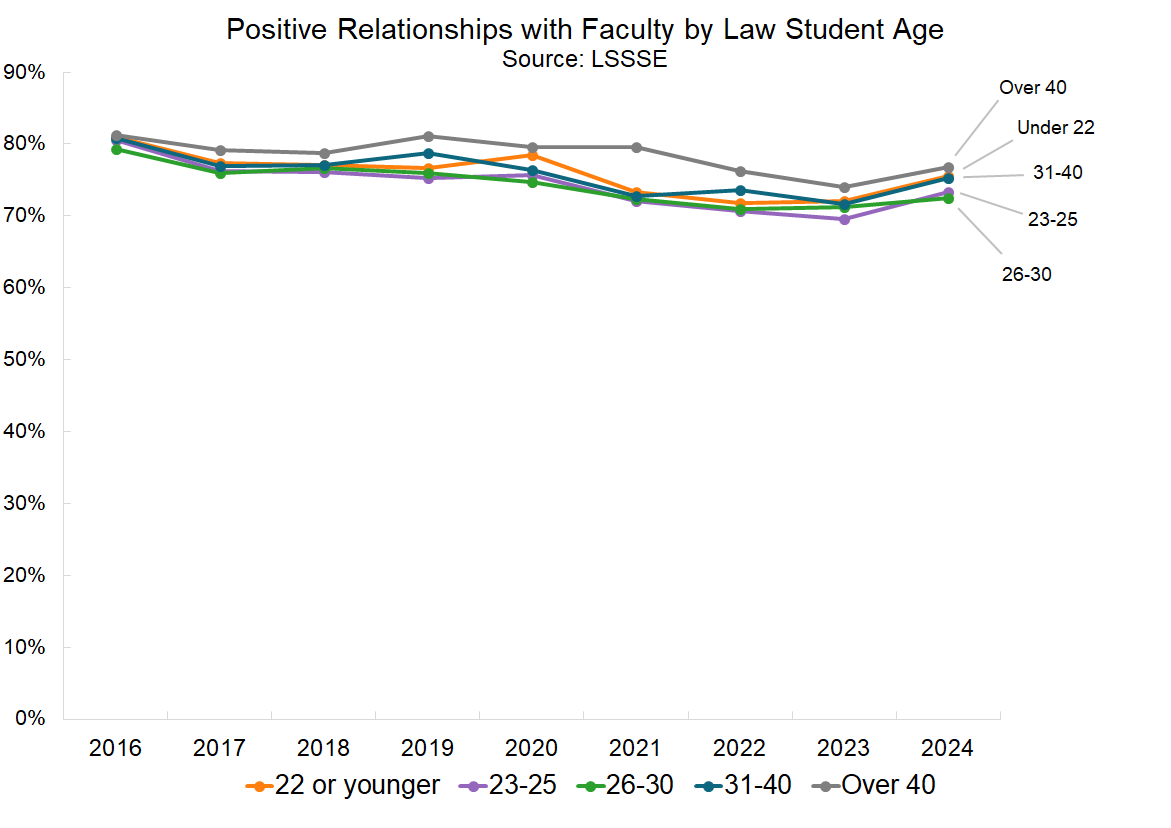
Age clearly matters at least to some degree when it comes to the quality of student/faculty and student/staff interactions. Older students tend to be satisfied with their relationships compared to younger students. This suggests that law schools might consider how they are facilitating the formation of these relationships and what tweaks might bring younger students into closer, more meaningful relationships with law school faculty and staff.
Evolving Support for Law Students: 20 Years of LSSSE
The 2024 LSSSE annual report 20 Years of LSSSE is now available on the LSSSE website. Our previous post examined trends in law student demographics. In this post, we will share some trends in student support services, both in terms of satisfaction with formal law school student services offices and relationships with faculty and staff.
A large part of overall student satisfaction with law school is likely due to strong bonds with others on campus. Student relationships with faculty and classmates have been compellingly positive over the past twenty years. Throughout the past two decades, over three-quarters (76-81%) of law students have consistently rated their relationships with classmates as five or higher on a seven-point scale. Peer relationships are the only ones to have remained in 2024 at the high levels of 2019, showing these bonds quickly recovered from any potential pandemic-related decline. Students also report strong bonds with professors. Roughly three-quarters (73-78%) of LSSSE respondents from 2004 to 2024 have rated relationships with faculty as positive, measured as five or higher on a seven-point scale. Though the current 73% of students reporting strong relationships with their professors is slightly down from 2019 levels (76%), it nevertheless remains high. Relationships between students and staff, on the other hand, are more concerning. From 2004 to 2019, roughly two-thirds (65-68%) of law students reported positive relationships with staff; in 2024, this figure dropped to 59%. While student-staff connections have never been as strong as those between students and faculty or students with peers, those reported in 2024 are the lowest ever recorded, revealing room for significant improvement in these relations post-pandemic.
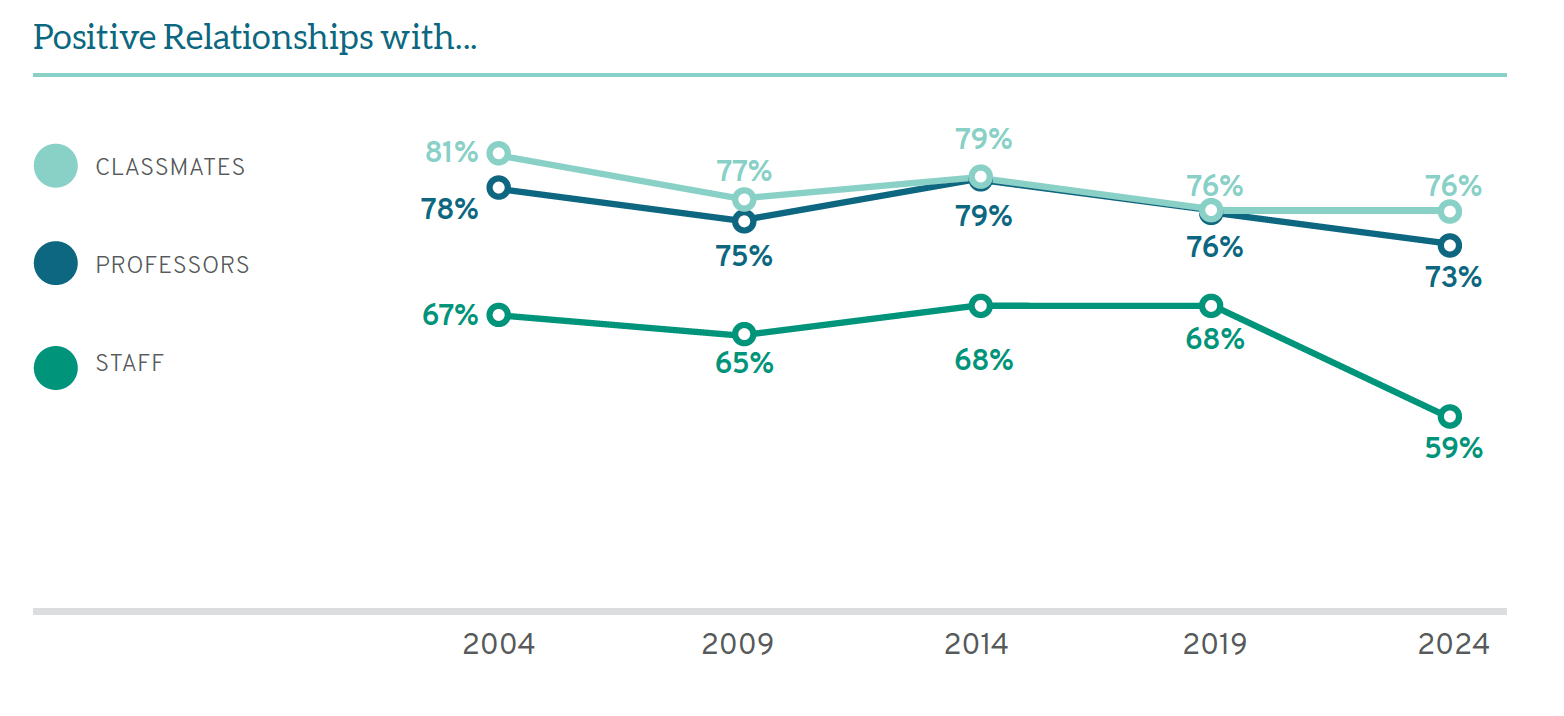
Because staff have many opportunities to interact with students in response to various issues, each contact provides an opportunity to strengthen bonds between them. Between 2004 (61%) and 2019 (71%), there were steady increases in satisfaction with academic advising; however, the percentage of law students reporting they were “satisfied” or “very satisfied” dropped to 64% in 2024. Whether due to COVID-19 or other reasons, student satisfaction with academic advising declined over the past five years, instead of continuing the steady progress it enjoyed through 2019. Because the percentage of students using academic advising remains particularly high (90-94% in the past decade), positive interactions with academic advising staff could be instrumental in improving student-staff relationships overall.
Most students also partake in advising opportunities with career services staff, including 87-92% of all students over the past twenty years. Though only half (51%) of students were “satisfied” or “very satisfied” with career counseling in 2004, that percentage also steadily increased over time for fifteen years through 2019. However, as with other staff services, the upward trend has stopped, with current student satisfaction with career counseling (64%) matching 2014 levels, down from 69% five years ago.

Satisfaction with personal counseling sessions also enjoyed incremental increases over time for fifteen years, from a low of 57% in 2004 to 65-67% in 2009 and 2014, to a high of 68% in 2019. Troublingly, satisfaction has dropped significantly in the past five years, down to only 60% of students who are “satisfied” or “very satisfied” with the personal counseling they receive. Although the myriad challenges of the pandemic and other upheavals in legal education and society writ large may suggest personal counseling is all the more necessary for law students today, only 60% used these services in 2024 (another drop from 68% who sought personal counseling in 2019).
Students also reported lower levels of satisfaction with job search help in 2024 than they did in 2019, with only 61% reporting they were “satisfied” or “very satisfied” with these services. Again, this reveals a break in the trend of increasing satisfaction with job search help from 2004 (49%) through 2019 (66%). The good news is that roughly the same percentage of students (83-85%) over the past decade have sought assistance with their job search; thus, opportunities remain to improve these interactions over time.
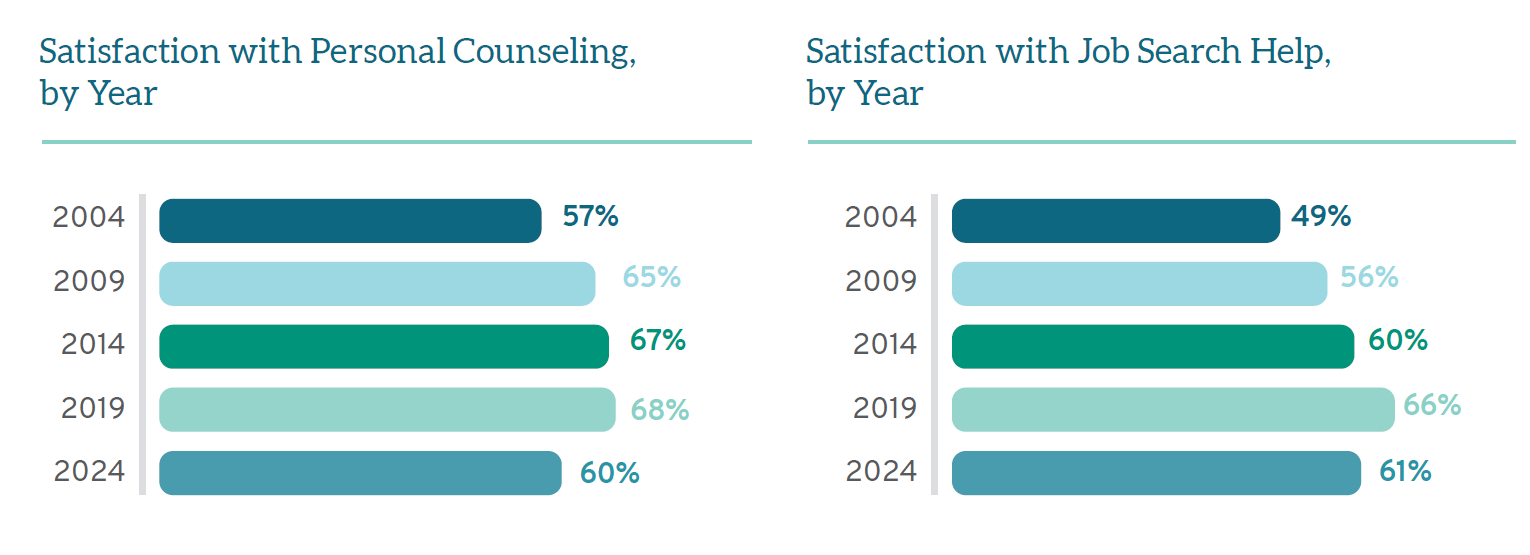
For more information on how the law student experience has changed over time, including overall satisfaction and trends in student debt, please visit the LSSSE website to read the entire report.
Diversity in Legal Education: A 20-Year Transformation
The 2024 LSSSE annual report 20 Years of LSSSE is now available on the LSSSE website. The report emphasizes the progress law schools have made in fostering inclusivity and preparing students for diverse workplaces while also addressing areas that need improvement, such as affordability and equitable support for all students. In this blog post, we will highlight some of the shifting demographics of the law student population that have occurred since LSSSE’s inaugural survey in 2004.
Law students are becoming an ever-more diverse bunch—though that progress may yet be stymied by the end of affirmative action as we know it. Over the past two decades, we have seen increases in diversity as measured by race, gender, age, and sexual orientation. Students of color, including those who identify as Black, Latinx, Asian American, Native American, and multiracial, accounted for just 17% of all LSSSE respondents in 2004; by 2024 their representation had grown to one-third (32%). In particular, the multiracial population has grown substantially (from 1% in 2004 to 10% in 2024, with roughly equal representation between multiracial men and women) as has the percentage of Latinx students (growing from 4% to 8% of law students in twenty years). Alarmingly, the Native American population has remained at or below 1% throughout the twenty years of LSSSE data collection, with a slight decline in recent years.
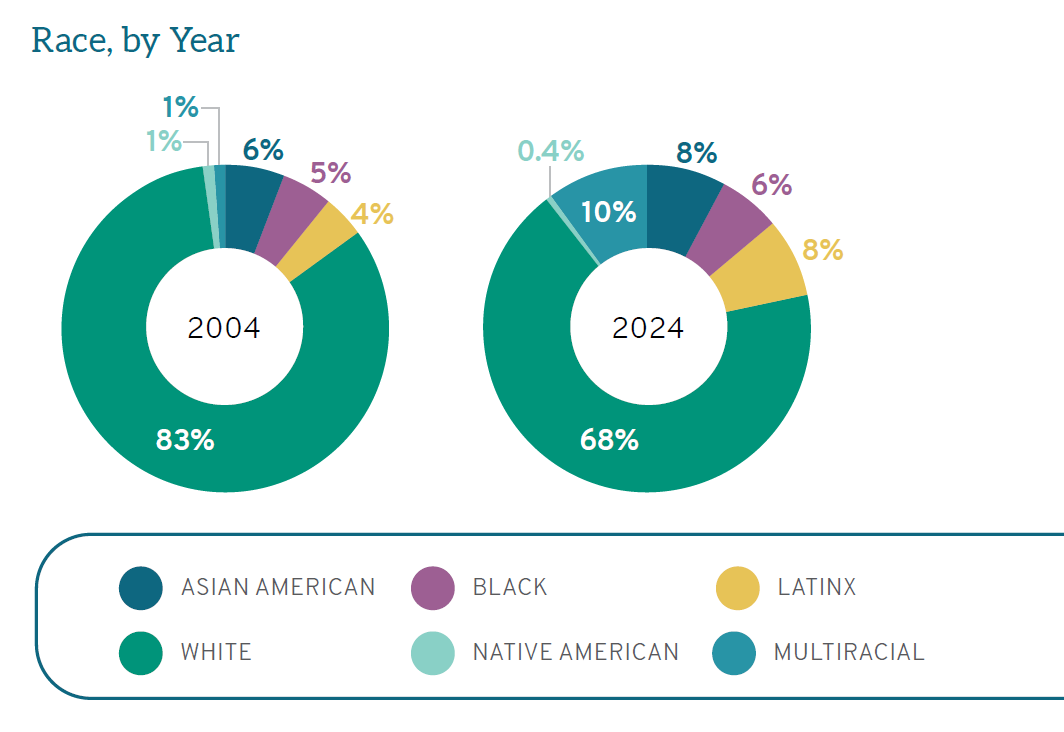
The percentage of women in legal education has continued to increase in the past decade, from 51-52% between 2004 and 2014 to now 60%. Law students are also trending younger, with a full 11% of current students reporting their age as under 23 years (compared to only 1% in 2004, up from 9% in 2019). There are also higher percentages of students identifying as lesbian, gay, or bisexual; currently, the LGBTQ+ population together represents 17% of all law students, up from just 4% in 2009 (as LSSSE first began collecting these data in 2005) and 9% in 2019. By any measure, legal education is more diverse now than at any point previously documented.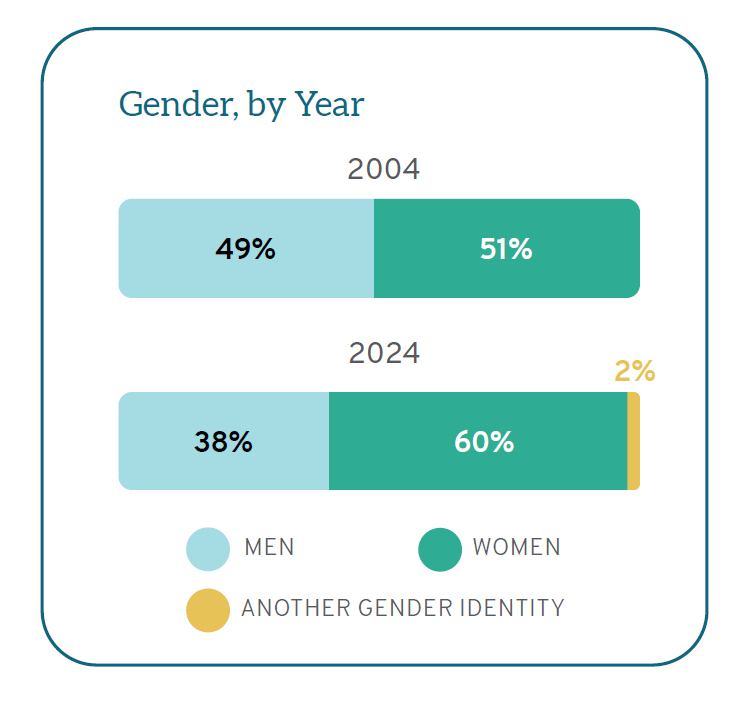
For more information on the shifts in legal education that occurred over the past twenty years, please visit the LSSSE website to read the entire report. In our next post, we will provide a snapshot of how support for law students has evolved over the last twenty years, including a concerning decrease in relationship satisfaction that warrants special attention.
Law Students are Highly Satisfied with Law Libraries
Law libraries are an essential cornerstone of legal education, providing students with the resources, spaces, and support needed to excel academically and to prepare for their future careers. Understanding how students feel about their law libraries is critical for ensuring these spaces and services effectively meet their needs. Exploring student satisfaction provides valuable insights into what is working well and where improvements can be made, helping law schools enhance the library experience and strengthen its role in fostering academic and professional success.
The Law Library topical module is an extension of the LSSSE survey that provides participating law schools with the opportunity to assess specific features of their law library including satisfaction with library training and support, quality of print and online resources, usefulness of physical spaces, and achievement of learning outcomes related to legal research. Today we will share satisfaction with some of the general features of academic law libraries using data from the 22 law schools that administered the Law Library module between 2022 and 2024.
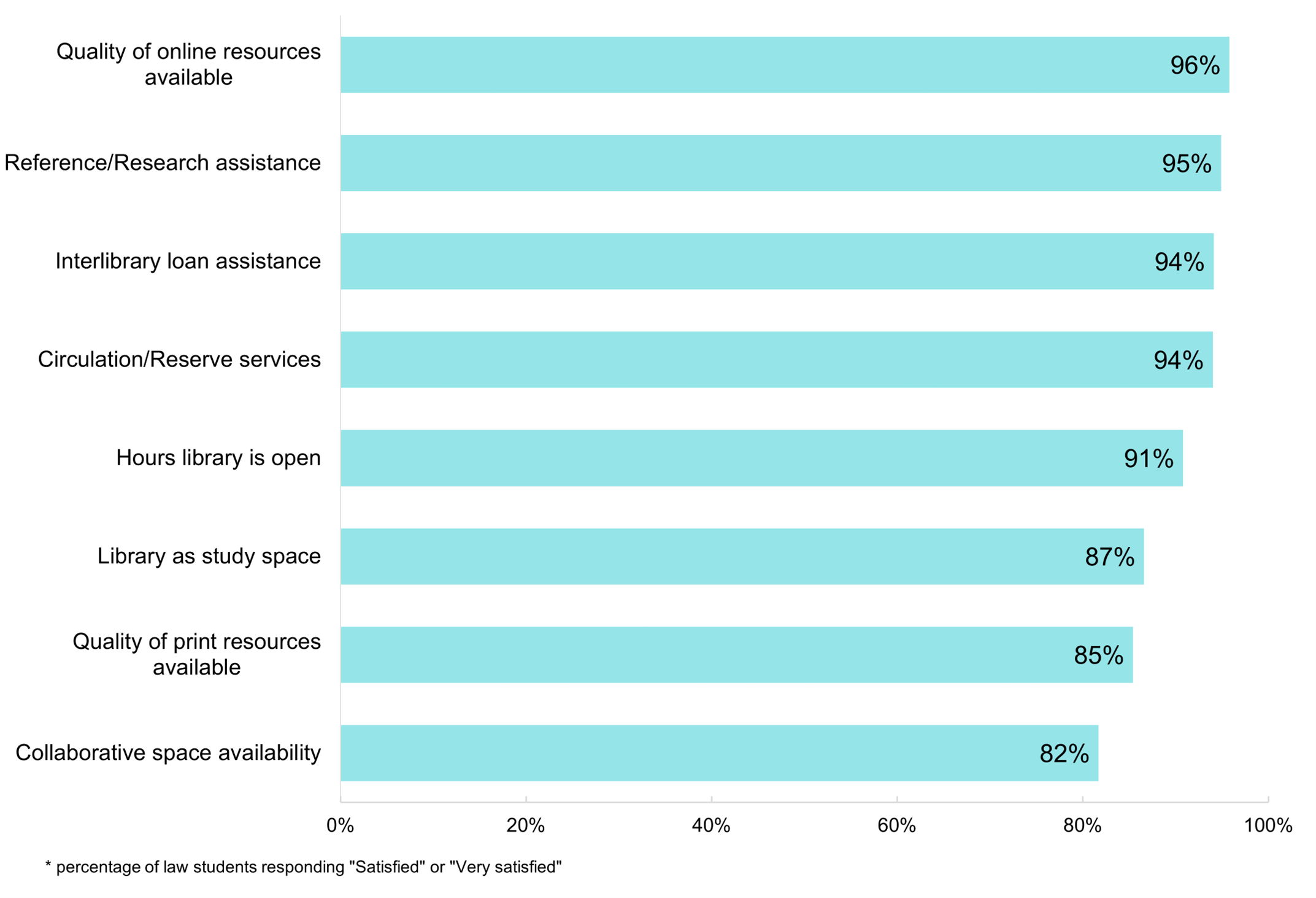
Four in five law students (82%) used the law library in the past year, and those students using the law library are are generally very satisfied with the services they receive. An astonishing 94+% of law library users are satisfied or highly satisfied with the quality of their law library’s online resources, reference/research assistance, interlibrary loan assistance, and circulation/reserve services. When students are dissatisfied with aspects of their library, their concerns are more likely to be related to access to the physical spaces, including hours the library is open (91% satisfaction), use of the library as a study space (87% satisfaction), and collaborative space availability (82% satisfaction). These satisfaction levels are still quite high, however, and this dissatisfaction can be viewed as a sign that students’ major complaints are that they want more of the library: longer hours and more collaborative and individual workspaces to use.
Law libraries play a vital role in shaping the academic and professional success of law students. The high levels of satisfaction with key library services underscore the critical support these libraries provide. The areas where students express less satisfaction highlight opportunities for growth, particularly in enhancing access to physical spaces. By listening to students' feedback and addressing their needs, law schools can ensure their libraries remain dynamic, indispensable resources that empower students to thrive.
Meaningful Sources of Career Advice for Law Students
Navigating career decisions can be one of the most challenging aspects of law school, and many students find themselves seeking advice to chart their path forward. Whether considering judicial clerkships, corporate law roles, public interest positions, or alternative legal careers, law students often feel a mix of excitement and uncertainty. Balancing academic demands with the pressure to make strategic choices about internships, networking, and future goals requires careful planning. And the guidance of mentors, professors, and peers can make all the difference.
Using 2023-2024 data from the LSSSE Student Services module, we examined the meaningful sources of career advice that law students draw upon to help with professional preparation. Interestingly, law students are more likely to seek out career advice from faculty or staff members not formally assigned as career advisors rather than from formal career advisors at their law school. Only about a third of law students receive meaningful advice from careers advisors available to any student, and only about a quarter receive meaningful advice from a career advisor assigned to them, which is equal to the percentage of students receiving meaningful advice from family members (26%).
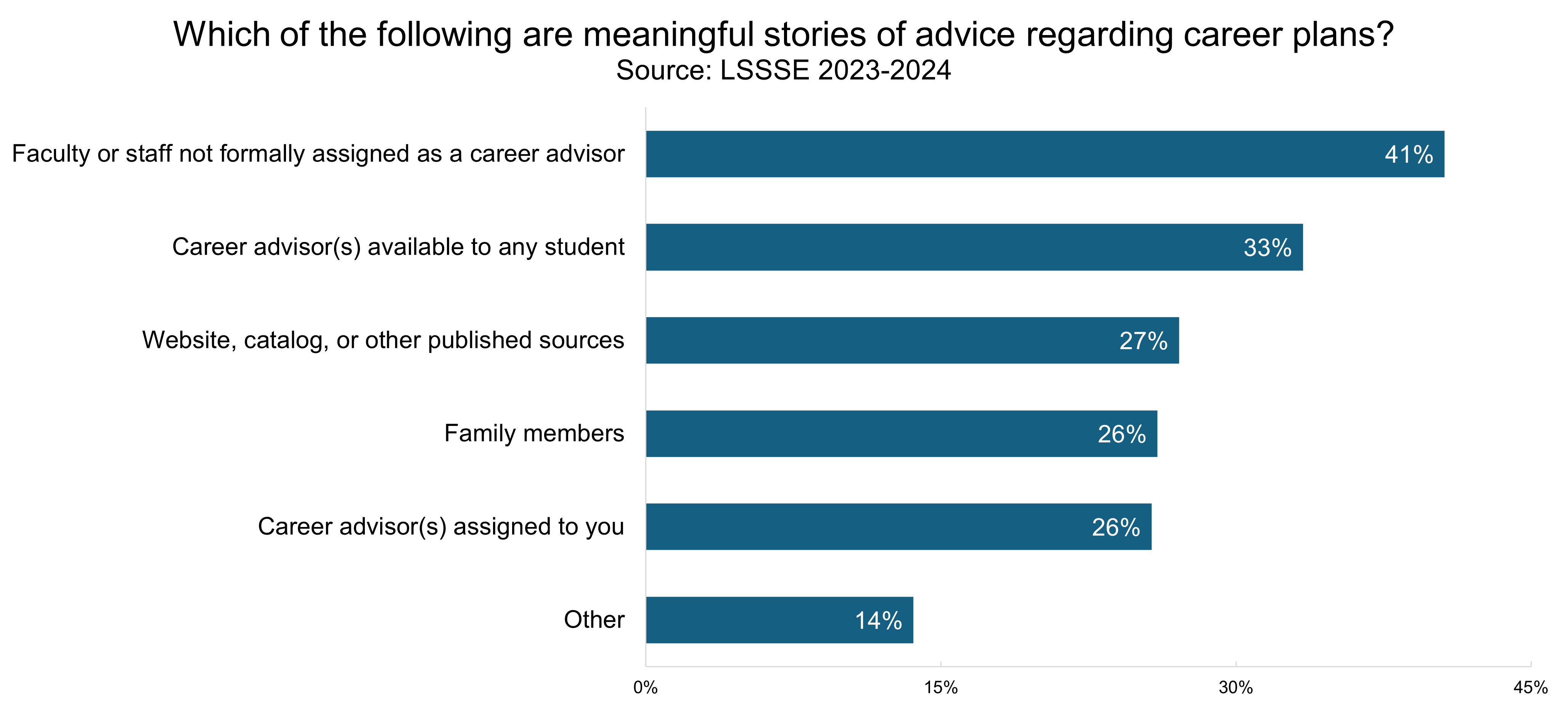
Given that family input will vary widely across different student backgrounds, we compared the sources of career advice for first-generation and non-first-generation law students. For first-generation law students (those who do not have a parent with at least a bachelor's degree), family members are much less likely to be a meaningful source of career advice. However, troublingly, first-generation students are also less likely to receive meaningful career advice from other sources relative to their non-first-generation peers. In other words, law schools may not be filling the gaps for first-generation students to support their transition into the legal profession.
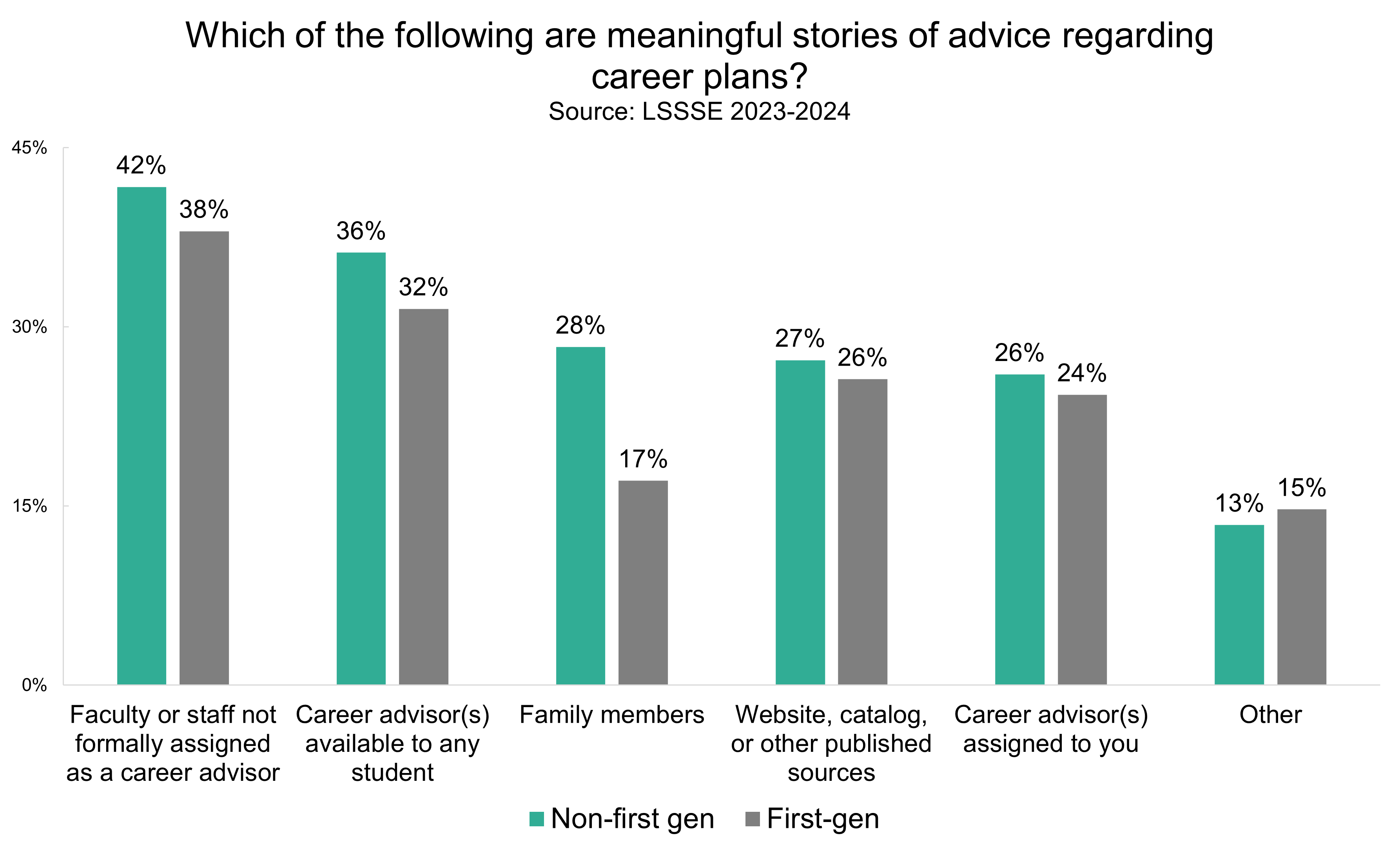
Digging deeper into the non-first-generation data, we wanted to know what impact having a parent with a law degree has on students’ sources of meaningful career advice. Among students who have a parent with a doctoral or professional degree, we see, not surprisingly, that students who have a parent with a JD are more likely to cite family members as a meaningful source of career advice than students who have a parent with a non-JD doctoral or professional degree. However, only around half (52%) of law students who have a parent with a JD note that they are receiving meaningful career advice from a family member. The students with a JD-holding parent are a little more likely to get advice from career advisors assigned to them and a little less likely to receive advice from faculty, staff, or career advisors who are not formally assigned to them.
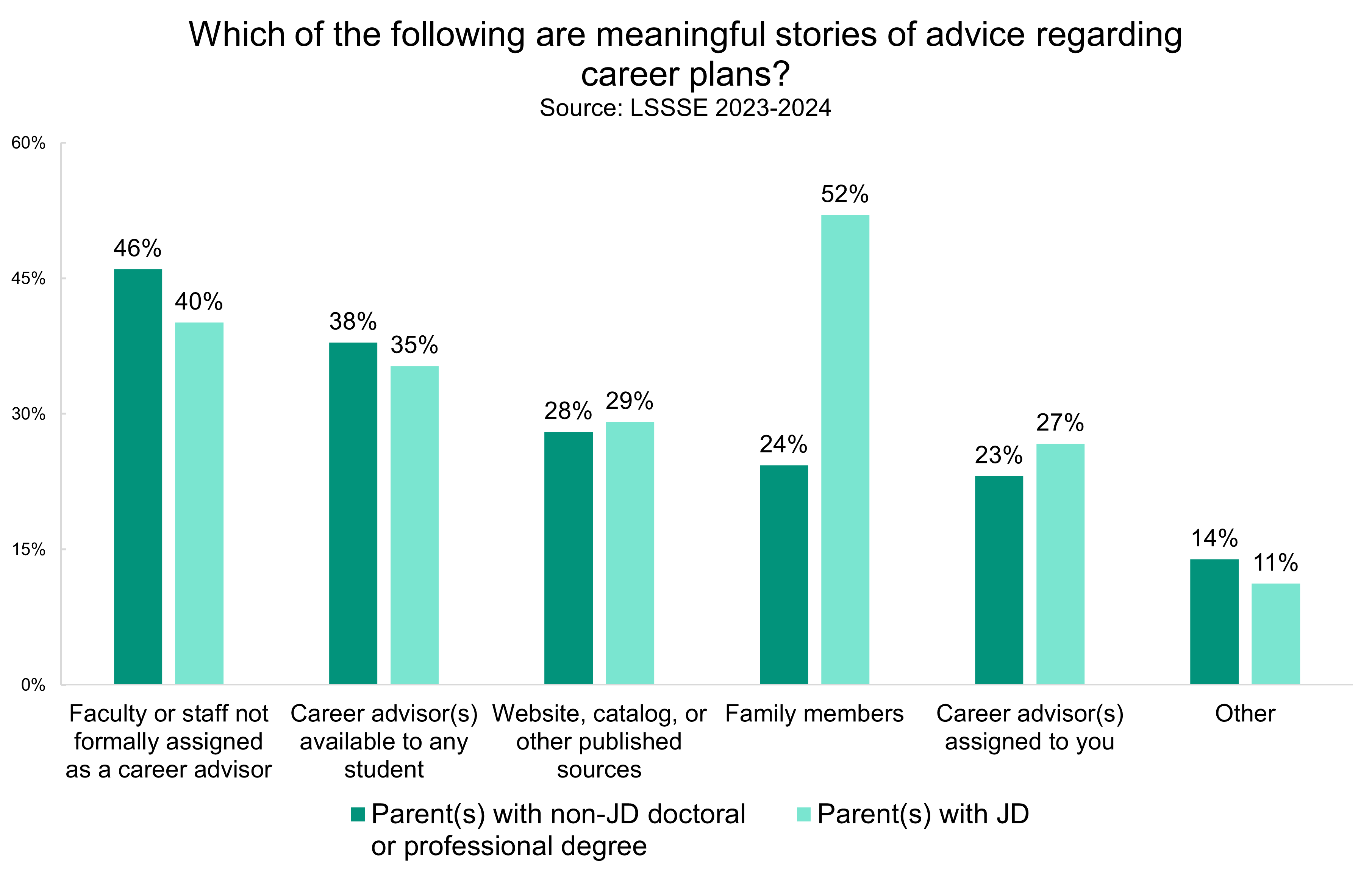
These findings highlight critical gaps and opportunities in how law schools support students in their career preparation. While informal networks and personal relationships with faculty or staff often play a vital role, the data suggest that formal career advising structures may not be as effective as they could be, particularly for first-generation students. Law schools should consider rethinking how they engage with students in career advising, ensuring that resources are accessible and tailored to meet the diverse needs of their student body. By strengthening these systems and bridging the advice gap, particularly for those from underrepresented backgrounds, law schools can better prepare all students for the challenges and opportunities of the legal profession.
Assessment of ABA Standard 303(c)
The American Bar Association (ABA) Standard 303(c) mandates that law schools provide students with substantial education on bias, cross-cultural competency, and racism to ensure they are equipped to serve a diverse client base and uphold justice in an inclusive legal environment. This requirement, effective for all law schools accredited by the ABA, emphasizes integrating this training at critical junctures in a law student's education, such as during orientation and within a course prior to graduation. Standard 303(c) encourages schools to create meaningful, context-specific programs that prepare future lawyers to understand and navigate the societal and cultural complexities affecting the legal system.
To aid law schools in evaluating their success toward meeting the requirements of Standard 303(c), LSSSE began asking questions about bias and anti-racism education during the 2024 survey administration. The question asks “During the current school year, in which of the following ways, if any, has your law school provided education on bias, cross-cultural competency, and racism? (Select all that apply.)” and gives the following options:
- Orientation sessions for incoming students
- Lectures on these topics
- Courses incorporating these topics
- Other educational experiences incorporating these topics
Substantial numbers of law students are receiving bias, cross-cultural competency, and anti-racism training in each of the four venues. Orientations for incoming students and courses incorporating these topics were the most selected answers, encompassing 71% of students. Two-thirds (67%) of students had received lectures on these topics, and a little over half (52%) of students participated in other educational experiences incorporating these topics.
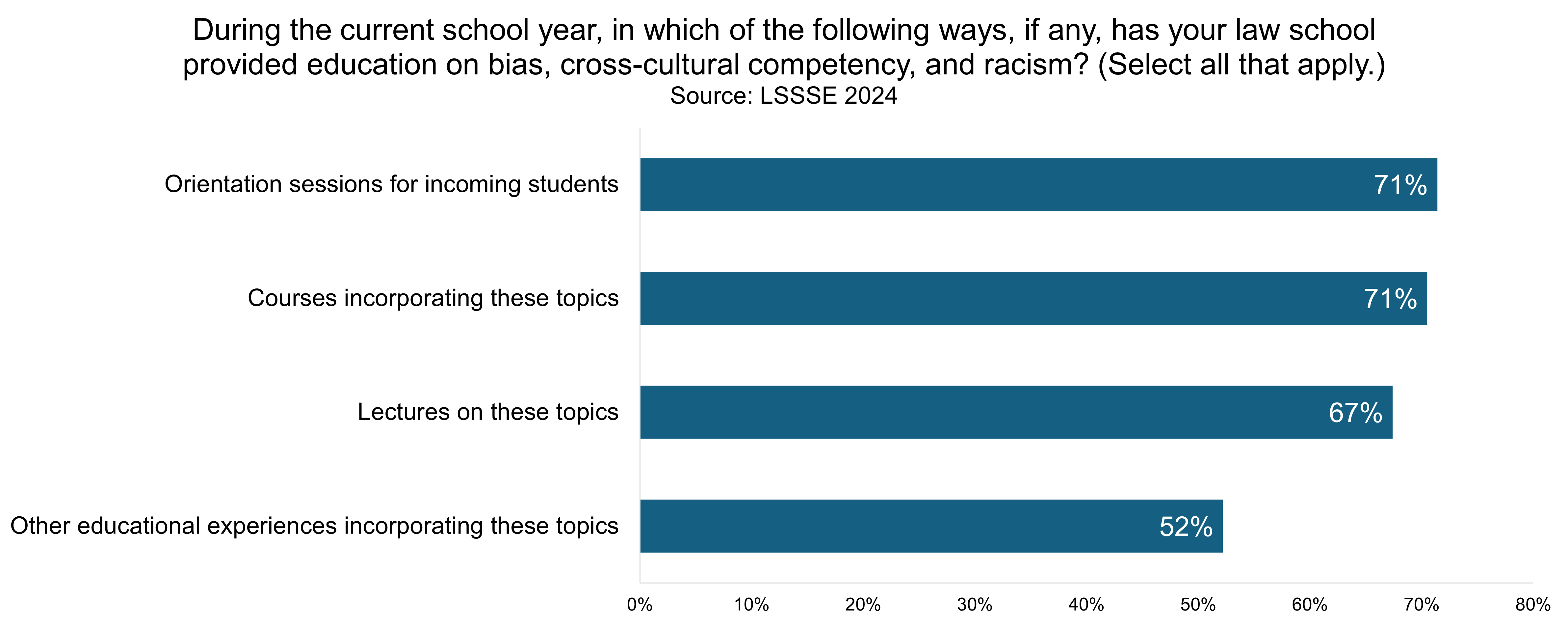
ABA Standard 303(c) represents a step toward fostering a more inclusive and culturally aware legal profession prepared to serve diverse communities with empathy, insight, and a commitment to equity. By mandating that law schools provide substantial education on bias, cross-cultural competency, and racism, this Standard ensures that future lawyers are equipped not only to recognize but also to challenge the social and cultural biases that can impact the justice system. LSSSE data show that the majority of law students are receiving this essential training through orientations, lectures, and integrated courses. To assess whether students at your law school are having these experiences and to compare your law students to the national averages, sign up for LSSSE 2025. Registration is now open.
Barriers to Choosing Public Interest Law Careers
Lawyers who practice public interest law are often driven by a desire to create positive social change and to advocate for marginalized or underserved communities. The work can be deeply rewarding as it allows lawyers to address issues like civil rights, environmental justice, housing, and access to healthcare. The sense of purpose and fulfillment from working on causes that align with personal values can be a significant motivator. However, there are potential barriers to pursing public interest work. To better understand these barriers, LSSSE partnered with Equal Justice Works in 2023 to survey students about how their law school supports public interest law, how their law school educates students on topics relevant to public interest law, and what barriers exist to pursuing a public interest law career. The joint final report that details the findings can be found here. In this blog post, we share some findings on the barriers to accepting a position in public interest law after graduation.
Law students were presented with a list of potential factors that would prevent them from taking a public interest law job after law school if they were offered one and instructed to select all the reasons that apply to them. Understandably, financial concerns were high on the list of reasons why students would choose not to accept a public interest law position. Nearly four out of five students (79%) cited low salary, and nearly half of students (45%) were concerned about their ability to pay off student debt. Interestingly, only about a third of students (34%) indicated they were motivated by more desirable opportunities in the private sector, and only a quarter (25%) cited a lack of interest in public interest law. This suggests students are attracted to public interest law, but their interest is tempered by financial considerations. One bright spot is that students do appear to be well-supported in law school guidance and resources for public interest careers. Only 7% of students cited a lack of this type of support as a barrier to pursuing a public interest career.
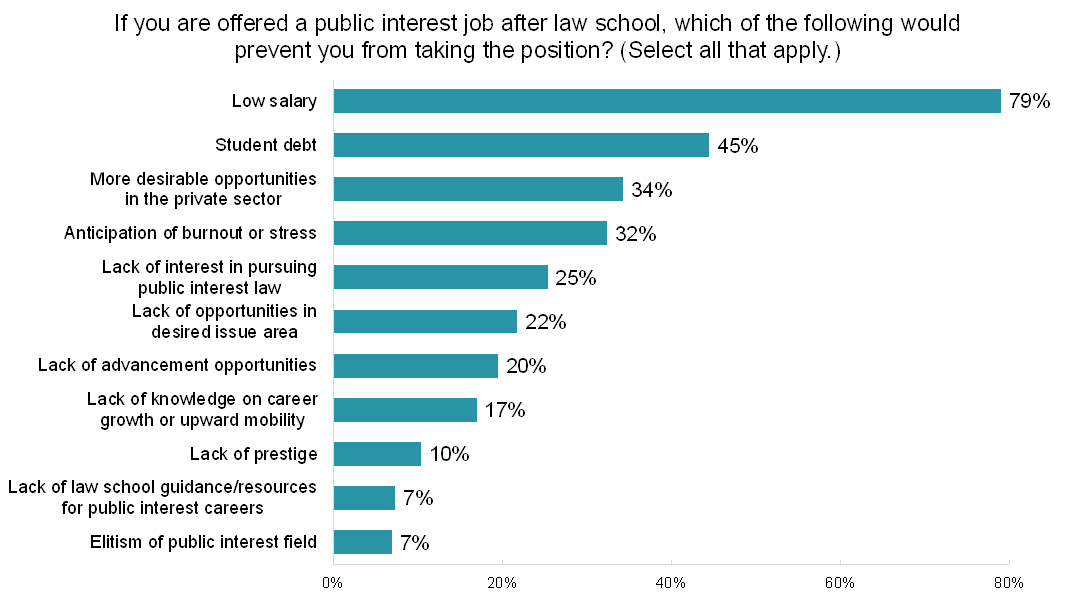
There are some notable gender differences in factors preventing students from taking a public interest law position. Men are more likely to see the private sector as more desirable and to have a lack of interest in public interest law. They are also more concerned than women and people of other gender identities about a lack of prestige and a lack of advancement opportunities or upward mobility in the public interest law sphere. People who do not identify as a man or a woman are less deterred by the prospect of a low salary, and they are less likely to see the private sector as more desirable or to cite a lack of interest in public interest law. However, they are the group most likely to be concerned about potential burnout or stress and to be concerned about elitism in the public interest field. Women tend to fall somewhere in between men and people of other gender identities in terms of which factors are most likely to deter them from taking a public interest job after law school. They are equally concerned about low salary as men, but they are less likely to cite a lack of interest or more desirable opportunities in the private sector as reasons not to pursue public interest. However, women are the least likely of all genders to cite a lack of opportunities in their desired issue area as a reason to avoid public interest.
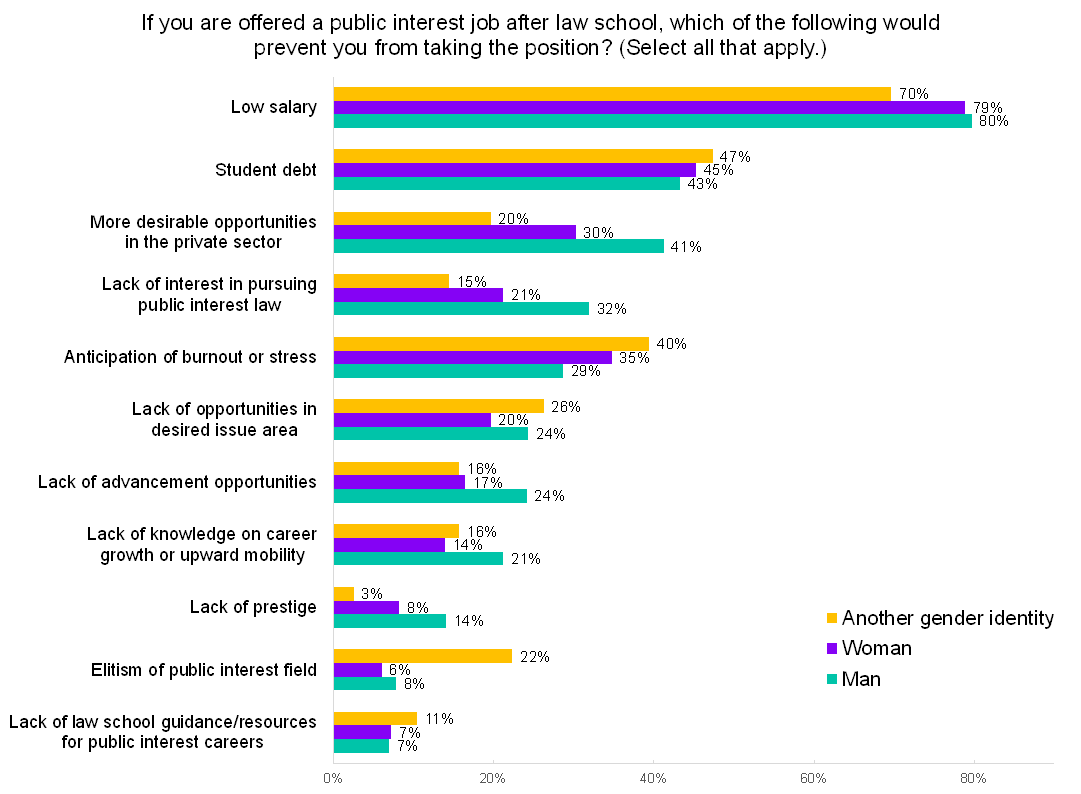
Some barriers to working in public interest law—such as financial considerations—are concerns of a large majority of students. However, some concerns are more salient to certain subgroups of students. Employers interested in recruiting and retaining new public interest lawyers may consider tailoring their efforts to address these issues in order to increase their ability to attract potential future employees.
Joint Degree and Certificate Programs
Law students may choose to pursue a joint degree or a certificate to enhance their academic and professional credentials by acquiring specialized knowledge and skills that complement the standard legal education. A joint degree program allows a student to earn two degrees in less time and with fewer credits than if they pursued each degree separately. Joint degree programs, such as those combining a Juris Doctor (JD) with a Master of Business Administration (MBA) or a Master of Public Administration (MPA), offer a comprehensive understanding of related fields, which broadens career opportunities and provides a competitive edge. Similarly, certificate programs in areas such as intellectual property law, environmental law, or international human rights allow students to gain targeted expertise that can be applicable in their future legal practice.
Just under three percent of LSSSE respondents were completing a joint degree in 2023 and 2024. Joint degree programs are often quite specific to the unique offerings of a particular law school. In fact, the most popular joint degree program on the survey is “Other, specify.” Of the LSSSE-provided options, the combined JD/MBA is by far the most popular choice among joint degree students (30%), followed by the JD/LLM (13%), the JD/MA (7%), and the JD/MPA (6%). Only 2% of joint degree students are pursuing a JD/PhD.
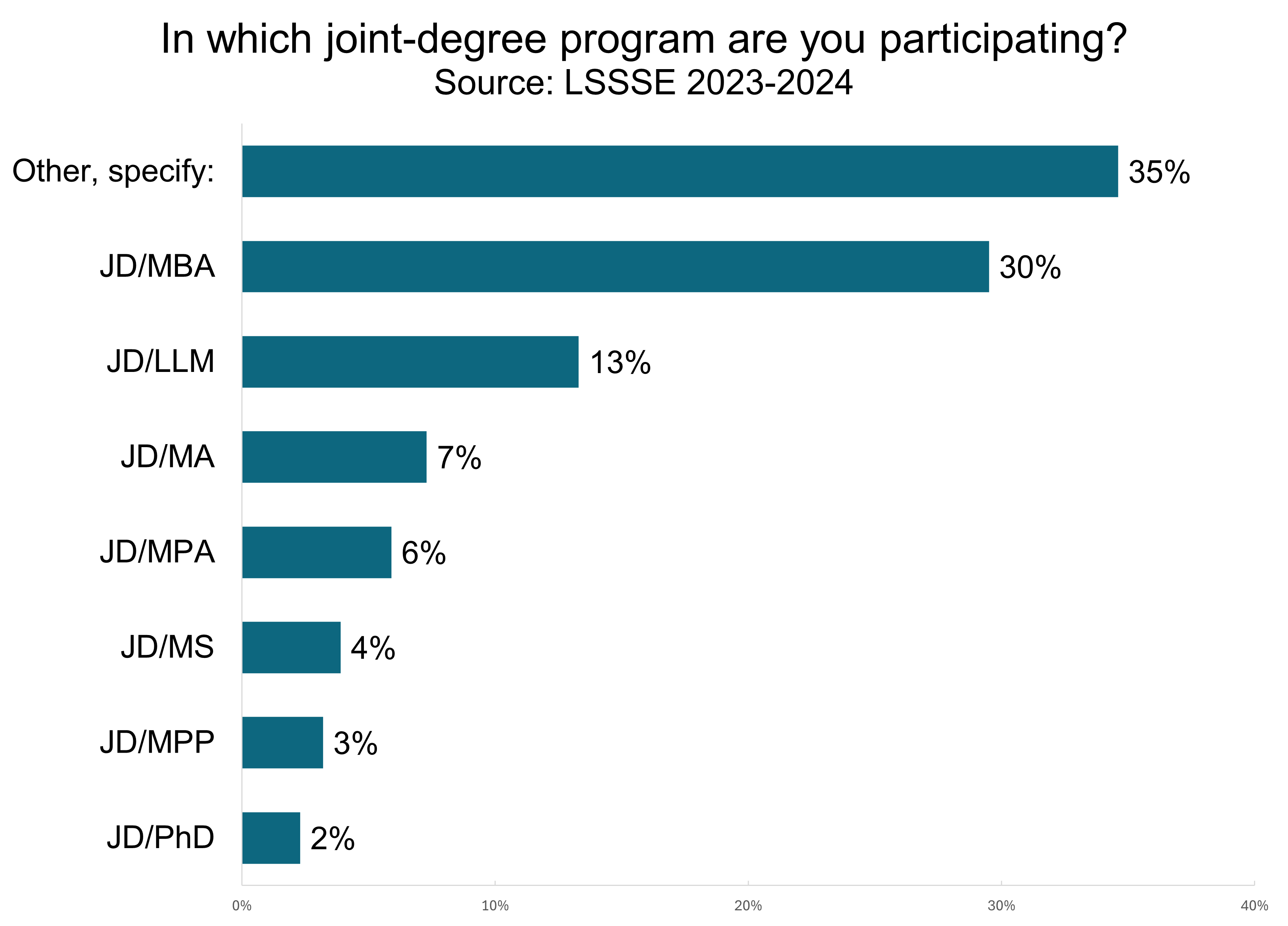
Certificate programs can provide additional content knowledge without the commitment of another entire degree, which makes them a somewhat more popular option. Nearly 11% of LSSSE respondents were pursuing a certificate in 2023 and 2024. The most common certificate program specializations included Health Law, Intellectual Property Law, Business Law, and Environmental Law.
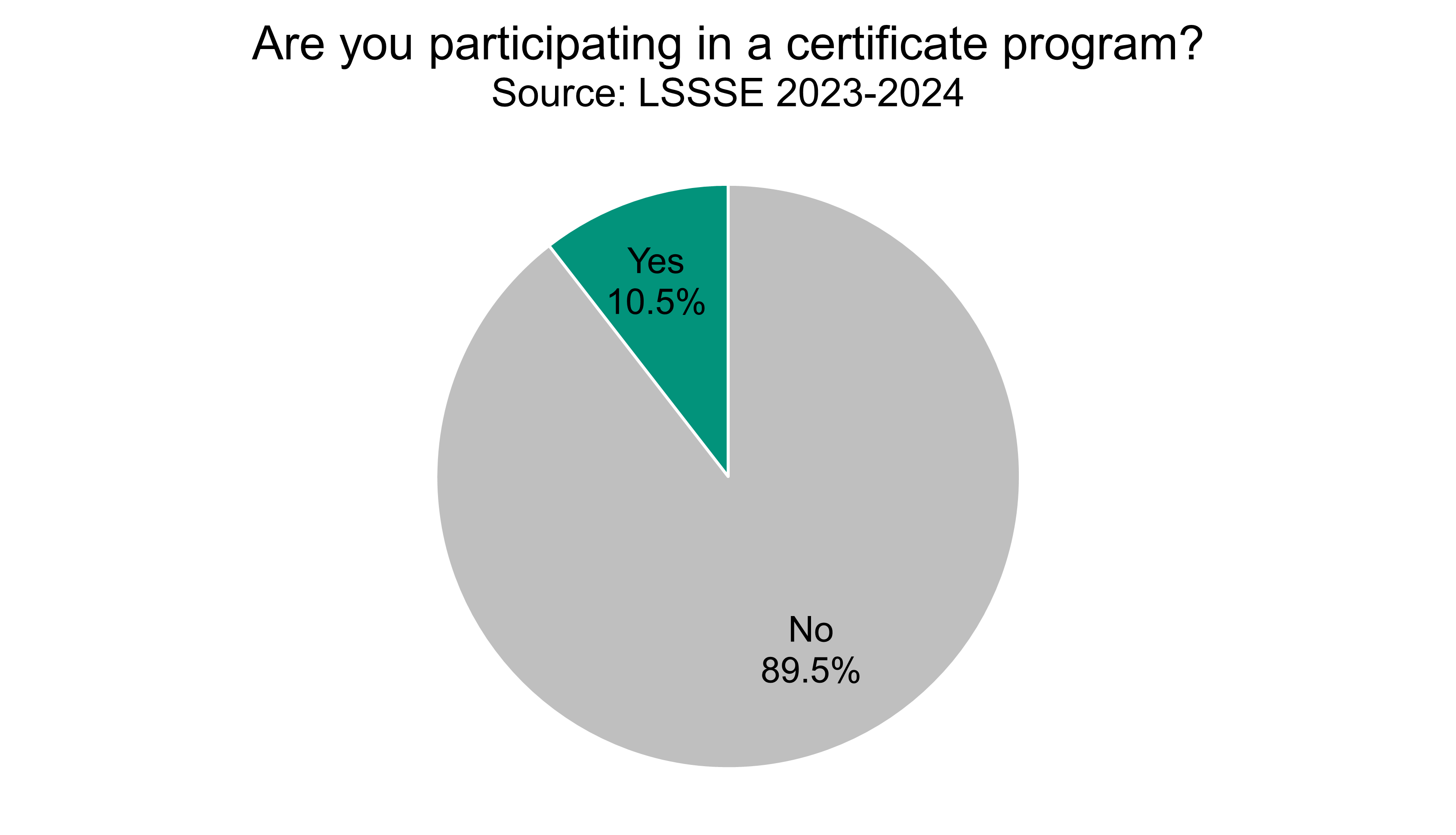
Law students appear to add on certificates as they progress through law school. Only 6% of 1Ls were pursuing a certificate, but among 3Ls, that number rose to 15%. It may be that 1L students do not realize the value, availability, or relative ease of completion of certificates during the course of completing their law degrees and only add them on once that has been made clear to them. This may signal that law schools could advertise their certificate offerings more clearly to prospective and incoming students. Interestingly, there is also a small difference in the percentage of students who are pursuing joint degrees across their years in law school. Around 2% of 1L students were completing a joint degree, compared to 3.2% of 3L students.
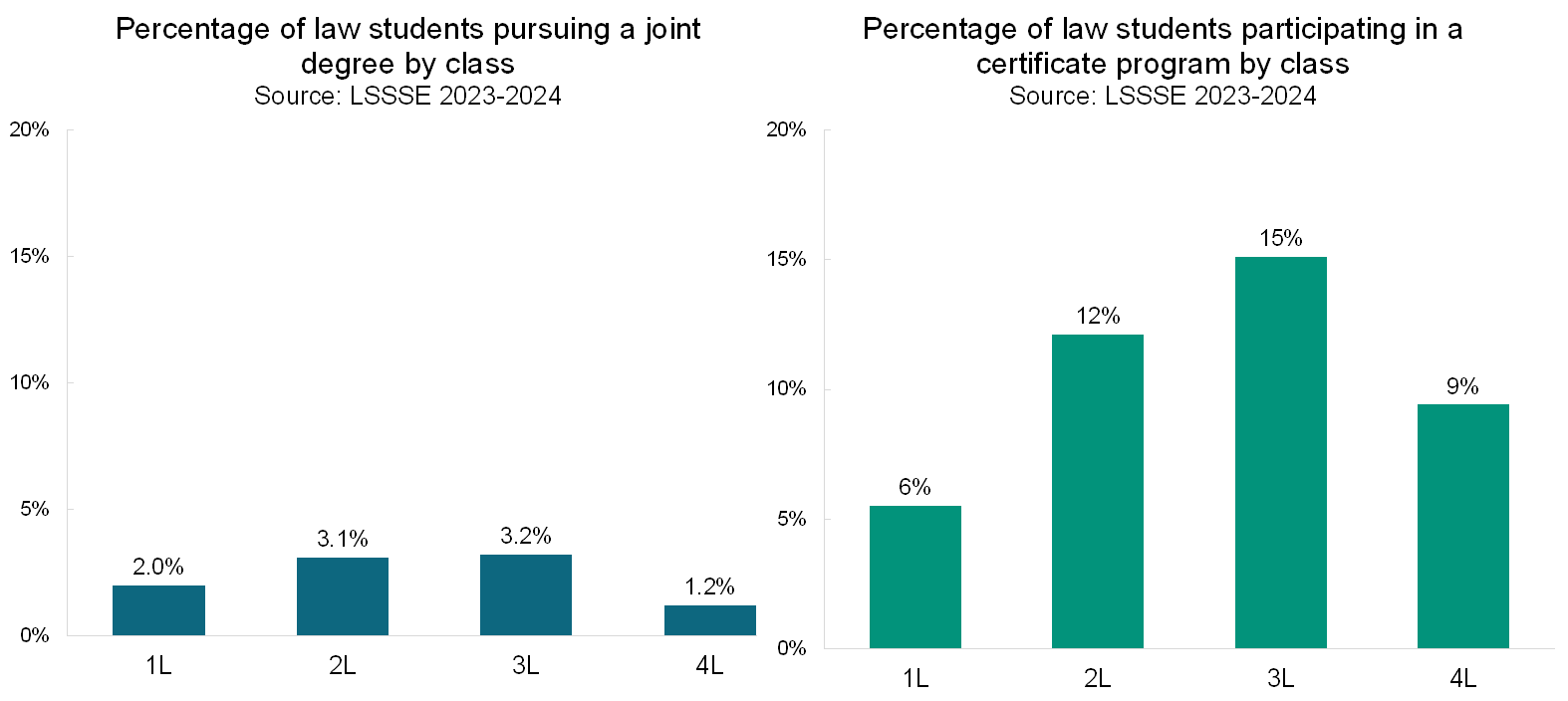 By completing joint degree programs and earning certificates, law students can demonstrate their commitment to interdisciplinary learning and their ability to integrate legal principles with other subject areas. These students ultimately enhance their versatility and effectiveness as practitioners in a complex legal landscape.
By completing joint degree programs and earning certificates, law students can demonstrate their commitment to interdisciplinary learning and their ability to integrate legal principles with other subject areas. These students ultimately enhance their versatility and effectiveness as practitioners in a complex legal landscape.
Learning to Think Like a Lawyer
Learning to think like a lawyer is crucial for developing essential analytical skills and a nuanced understanding of legal principles. This process involves honing the ability to critically assess legal issues, construct persuasive arguments, and anticipate counterarguments. Learning to think like a lawyer is challenging because it requires a shift in mindset and the development of complex analytical skills. Law students must master intricate legal concepts and apply them to varied contexts, often under pressure. This involves not only understanding the law but also critically analyzing case precedents and identifying subtle distinctions. Additionally, the emphasis on precision in language and argumentation can be daunting, as even minor errors can significantly impact legal outcomes. By the time they are ready to graduate, most law students have learned to cultivate a mindset that prioritizes logical reasoning and ethical considerations, which are vital for effective advocacy. Ultimately, mastering this way of thinking not only prepares students for successful careers in law but also equips them to navigate complex societal issues with integrity and insight.
LSSSE provides a Learning to Think Like a Lawyer (LTTLL) Engagement Indicator that is a succinct metric for understanding the degree to which students are engaging in this learning process. The LTTLL Engagement Indicator combines several individual survey questions that are statistically and conceptually related to one another. This makes Engagement Indicators meaningful for comparisons because they reduce the risk of relying too heavily on any individual survey question. The LTTLL Engagement Indicator combines the following questions from the main LSSSE survey:
During the current school year, how much has your coursework emphasized the following mental activities?
- Analyzing the basic elements of an idea, experience, or theory, such as examining a particular case or situation in depth, and considering its components
- Synthesizing and organizing ideas, information, or experiences into new, more complex interpretations and relationships
- Making judgments about the value of information, arguments, or methods, such as examining how others gathered and interpreted data and assessing the soundness of their conclusions
- Applying theories or concepts to practical problems or in new situations
The response options are “very much,” “quite a bit,” “some,” and “very little.”
Of the four cognitive activities, students are most heavily engaged in analyzing the basic elements of an idea, experience, or theory. Ninety percent of law students do this often or very often. Next comes applying theories or concepts to practical problems or in new situations (85%) and synthesizing and organizing ideas, information, or experiences into new, more complex interpretations and relationships (84%). Three-quarters (75%) of law students frequently make judgments about the value of information, arguments, or methods, such as examining how others gathered and interpreted data and assessing the soundness of their conclusions.

There are some interesting differences in how students respond to these questions across class years. 1L students are more likely to frequently engage in all the LTTLL mental activities compared to 2L and 3L students. For example, 93% of 1L students frequently analyze the basic elements of an idea, experience, or theory, compared to only 86% of 3L students. Generally, 1L students are somewhat more engaged with the law school experience and more enthusiastic overall relative to their more seasoned peers, so that might explain this discrepancy. However, it is also possible that 3L students have become so fluent with these processes that they do not necessarily note them in isolation from the type of legal thinking which has become automatic to them.
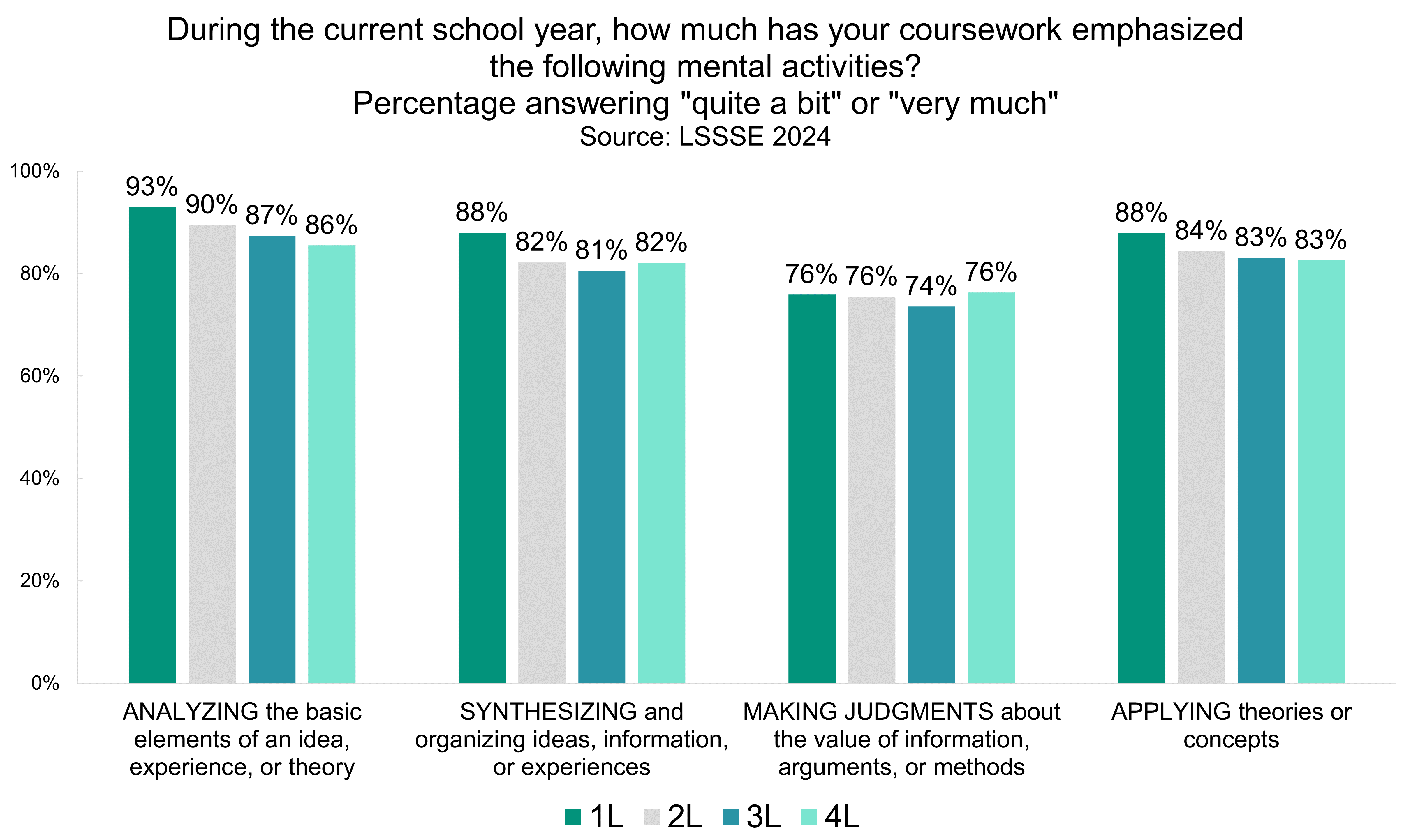
By applying legal theories and concepts to real-world scenarios, aspiring lawyers learn to navigate the intricacies of the law, develop strategic approaches, and ultimately advocate effectively for their clients. This comprehensive skill set is essential for rigorous legal thinking and practice. LSSSE provides customized tools to gauge how well your students are learning these crucial mental processes as well as ways to compare your students to selected peers and national averages. Contact us to learn more.
Artificial Intelligence and JD Students
Artificial intelligence (AI) is the ability of machines to perform tasks that normally require human intelligence, such as reasoning, learning, or decision making. AI has been applied to various domains, including law, where it can assist in research, drafting, analysis, or prediction. However, the use of AI in the law is certainly not without controversy, particularly given the high-profile and embarrassing incidents in which lawyers who had not properly vetted their AI bot’s research included AI hallucinations in court filings.
Institutions of higher education are currently grappling with the question of whether artificial intelligence is an essential tool of the future workforce or a means by which students may attempt to bypass their own educational enrichment and critical thinking skill development. We wanted to know how often JD students are currently using AI in their law school coursework. In 2024, LSSSE added the following question:
How often do you use AI (ChatGPT or similar technology) to help prepare for class or complete class assignments, projects, exams, or papers?
- Never
- Sometimes
- Often
- Very often
Our analysis shows that most law students are not currently using AI in their coursework at all. Almost three-quarters (72%) never use AI to prepare for class or complete assignments. A quarter of law students (25%) sometimes use AI in their coursework, and only 4% use it often or very often.
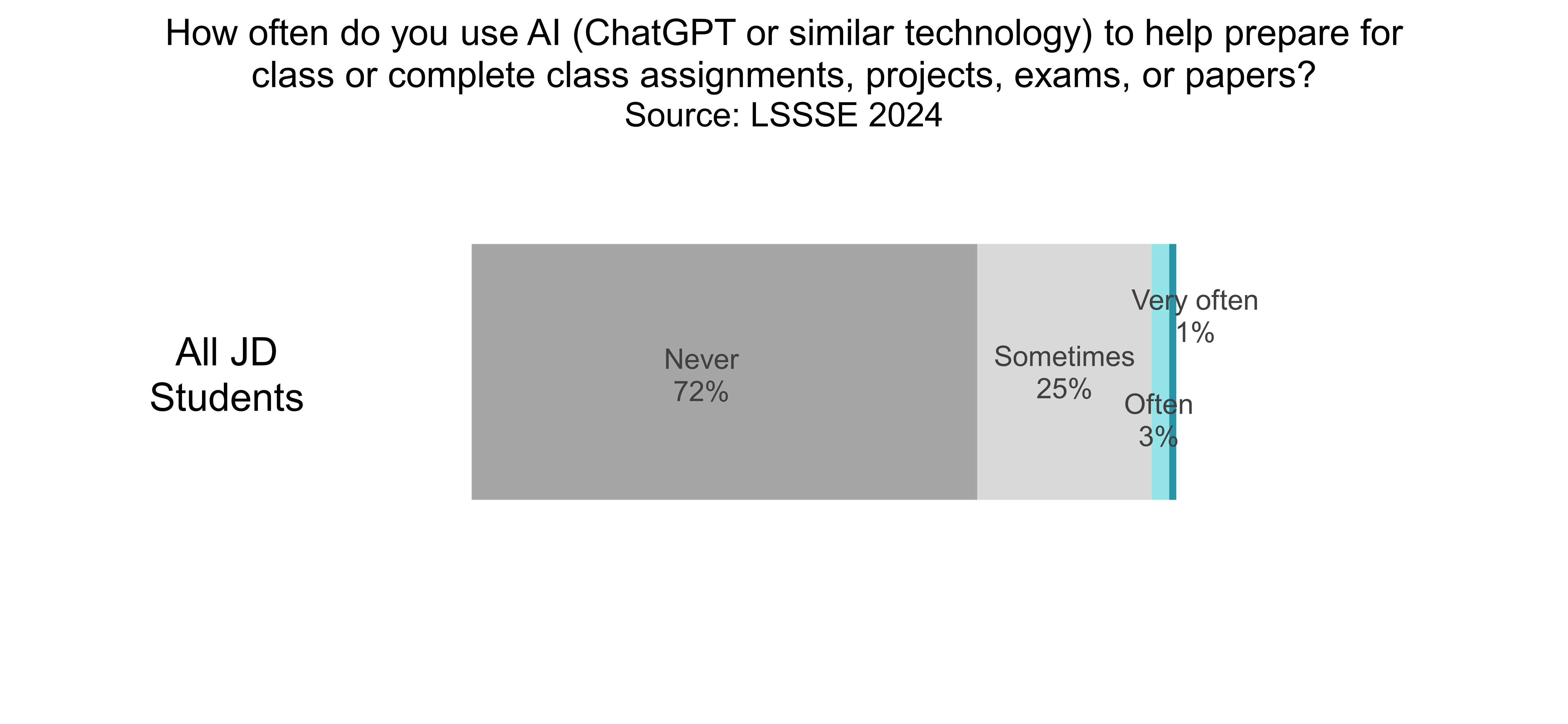
There are only slight generational differences in AI usage, with students in the 23-30 age group a perhaps a tiny bit more likely to use AI than other students. Interestingly, law students who are 22 or younger are the least likely age group to use AI for class preparation or assignments, with only 22% doing so at least sometimes.
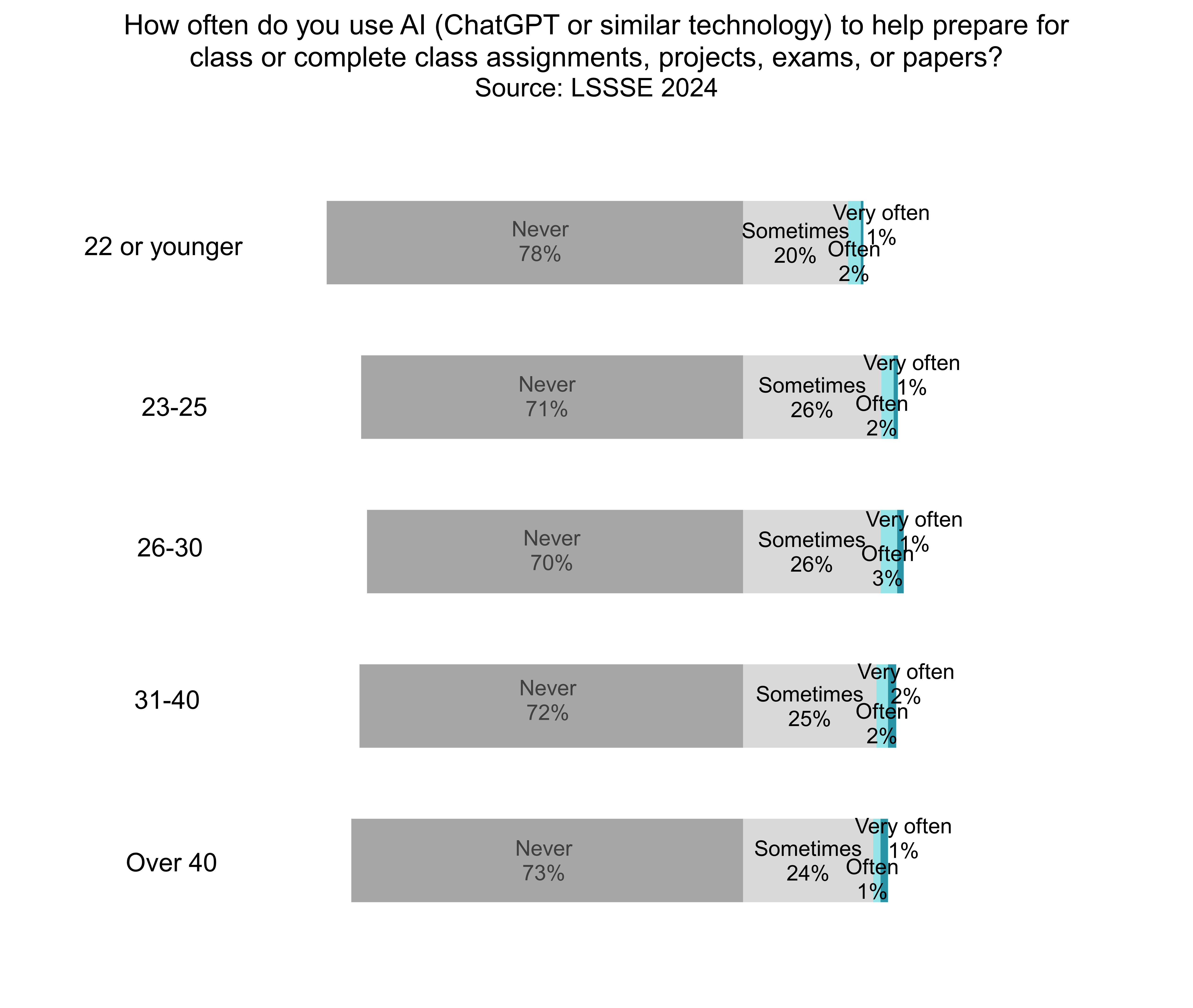
However, international law students are much more likely than domestic law students to use AI for their law school coursework. Almost half of international law students (48%) use AI at least sometimes compared to only 27% of domestic law students. This parallels a larger trend in undergraduate education in which U.S. college students are much less likely to use AI than their counterparts elsewhere in the world. International students attending U.S. law schools who speak English as a second language may be drawn to AI because of the ways it can be harnessed to support the unique needs of multilingual students, particularly in decoding complex texts. Whether AI usage for this or any other purpose is necessarily desirable remains to be seen, although it is useful to note that students are already accessing and using these tools.

AI usage among law students in the U.S. is currently quite low, with most students never using it for their coursework. There are some variations by age and nationality, particularly with international law students using AI tools at a much higher rate than domestic law students. Law schools would be wise to pay attention to both the potential benefits of AI for legal research and writing, as well as the challenges and limitations of AI in the legal domain. LSSSE will continue to track AI usage to understand the degree to which law students are using these tools in their pursuit of learning and understanding the law.




